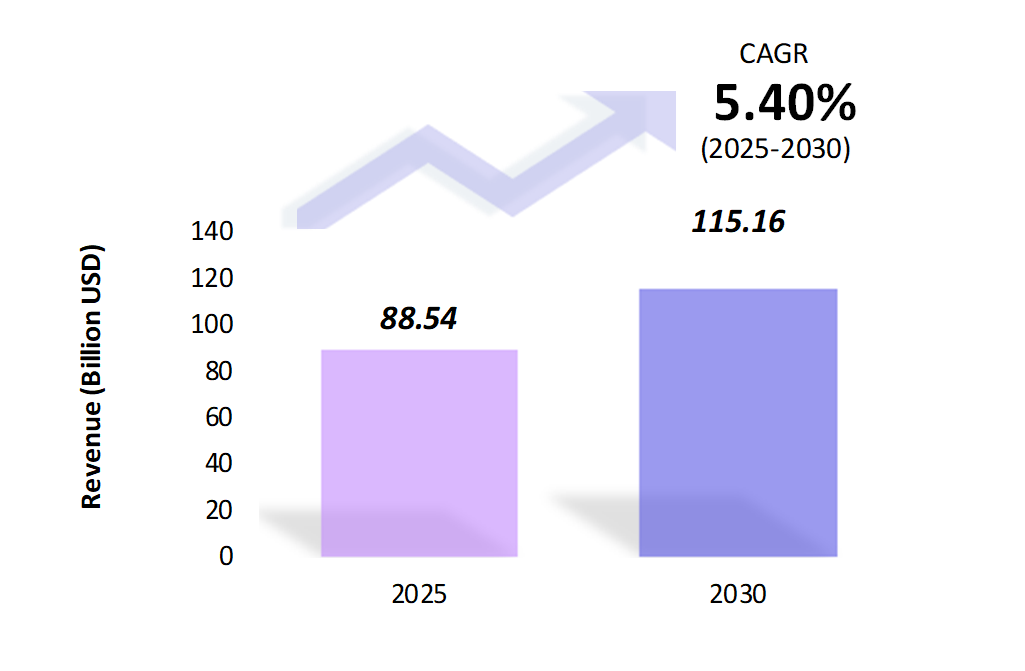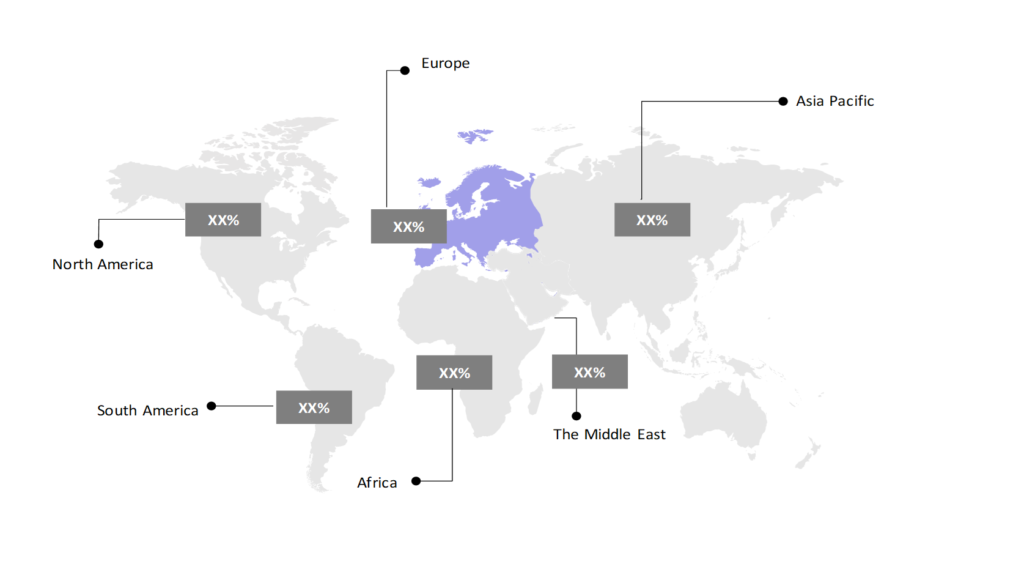Ice Cream Market Insights: Size, Share, Growth Analysis & Forecast (2024-2029)
The market report presents a thorough analysis segmented by Product (Sticks/Bars, Cones & Cups, Tubs & Bricks, Others); by Flavor (Chocolate, Vanilla, Tutti Frutti, Blends, Others); by Geography (North America, South America, Asia Pacific, Europe, The Middle East, Africa).
Outlook

- The ice cream market is estimated to be at USD 88.54 Bn in 2025 and is anticipated to reach USD 115.16 Bn in 2030.
- The ice cream market is registering a CAGR of 5.4% during the forecast period 2025-2030.
- The global ice cream market has shown consistent growth driven by increased consumer demand for indulgent and innovative frozen desserts. Key factors include the rising preference for premium and artisanal ice cream, increased health-conscious product lines, and expanding consumption in emerging markets. Seasonal trends, evolving flavors, and technological advancements in production also contribute to market growth.
Request a free sample.
Ecosystem

- The participants in the global ice cream industry are always developing their strategies to preserve a competitive advantage.
- These companies primarily use acquisitions, research & developments, partnerships, and technological launches.
- Several important entities in the ice cream market include Nestlé S.A.; Unilever PLC; General Mills, Inc.; Wells Enterprises, Inc.; Lotte Reit Co., Ltd.; and others.
Ask for customization.
Findings
| Attributes | Values |
|---|---|
| Historical Period | 2019-2023 |
| Base Year | 2024 |
| Forecast Period | 2025-2030 |
| Market Size (2025) | USD 88.54 Bn |
| Market Size (2030) | USD 115.16 Bn |
| Growth Rate | 5.4% CAGR from 2025 to 2030 |
| Key Segments | Product (Sticks/Bars, Cones & Cups, Tubs & Bricks, Others); Flavor (Chocolate, Vanilla, Tutti Frutti, Blends, Others); Geography (North America, South America, Asia Pacific, Europe, The Middle East, Africa) |
| Key Vendors | Nestlé S.A.; Unilever PLC; General Mills, Inc.; Wells Enterprises, Inc.; Lotte Reit Co., Ltd. |
| Key Countries | The US; Canada; Mexico; Brazil; Argentina; Colombia; China; India; Japan; The UK; Germany; Italy; France; UAE; Saudi Arabia; Egypt; South Africa |
| Largest Market | Europe |
Get a free quote.
Trends
- Emergence of Novelty Flavors and Customization: The emphasis on unique and customizable flavors has emerged, with artisanal and small-scale producers experimenting with new combinations like matcha, tahini, and exotic fruit blends. For example, in 2022, Baskin-Robbins introduced limited-edition flavors inspired by global culinary trends, enhancing customer engagement.
- Shift Towards Plant-Based and Dairy-Free Alternatives: Consumers increasingly turn to plant-based ice cream as they prioritize healthier, dairy-free alternatives that cater to dietary preferences like veganism, lactose intolerance, and gluten sensitivity. This shift is also emphasized by growing environmental awareness, as plant-based options generally have a lower carbon footprint and require fewer natural resources than traditional dairy products.
- Development of Artisanal and Handcrafted Ice Cream: The craft and small-batch ice cream trend is gaining emphasis as consumers prioritize quality over mass-produced options. Companies like Jeni’s Splendid Ice Creams have successfully tapped this demand by offering premium, artisanal flavors made with high-quality, often locally sourced ingredients. This focus on craftsmanship and unique flavor profiles appeals to those seeking a more indulgent, personalized dessert experience.
Speak to analyst.
Catalysts
- Increasing Disposable Income and Urbanization: As urbanization grows, particularly in developing nations, consumers with higher disposable incomes increasingly spend on indulgent food items like premium ice cream. This shift is driven by a desire for luxury and novelty, with many seeking high-end, unique dessert experiences to treat themselves. The rise in consumer spending fuels demand for premium ice cream brands and artisanal options, reflecting a broader shift toward quality over quantity.
- Innovative Product Launches and Expansion: Ongoing product innovation, such as introducing lactose-free, sugar-free, and probiotic-enhanced ice cream options, is fueling market growth. In 2022, companies like Unilever and Nestlé expanded new product categories to cater to diverse dietary preferences, driving competition and increasing growth. This innovation helps brands meet the growing demand for healthier, functional desserts, expanding their consumer base and boosting overall market dynamics.
- Seasonal Promotions and Marketing Strategies: Seasonal and holiday promotions are a significant driver of consistent demand for ice cream, as they create excitement and urgency among consumers. Companies often capitalize on peak seasons by launching targeted marketing campaigns and exclusive, limited time flavors or offers. These promotions not only encourage impulse purchases but also enhance brand visibility and customer loyalty. By aligning product launches with holidays and seasonal events, ice cream brands can tap into heightened consumer spending, fueling market growth and boosting sales during key times of the year.
Inquire before buying.
Restraints
- Rising Costs of Raw Materials: Rising costs of key ingredients such as dairy, cocoa, and sugar have become a significant challenge for the ice cream industry. Supply chain disruptions and inflation have driven up the prices of these essential components, impacting production costs. As a result, manufacturers are facing increased expenses, which may ultimately affect pricing and profitability across the market.
- Low Shelf Life and Seasonality: Ice cream is a frozen dairy product with a limited shelf life of 2-3 months, but improper storage can cause spoilage within days. If not stored in optimal conditions, ice cream may develop off odors, bacterial growth, and absorb undesirable flavors from the surrounding environment, such as paint or ammonia. These issues, along with high storage costs, pose challenges to market growth. Additionally, while demand for ice cream is strongest during the summer, it tends to decrease sharply during the winter and monsoon seasons, further affecting overall market performance.
- Regulatory and Health Concerns: Stringent food safety regulations and health labeling requirements present challenges for ice cream manufacturers. Compliance, especially in regions with complex policies like the European Union, often requires substantial investment in quality control and product reformulation. These regulatory demands can increase operational costs and complexity, potentially impacting profitability and production timelines.
Personalize this research.
Hotspot

Explore purchase options.
Table of Contents
| 1. Introduction 1.1. Research Methodology 1.2. Scope of the Study 2. Market Overview / Executive Summary 2.1. Global Ice Cream Market (2019 – 2023) 2.2. Global Ice Cream Market (2024 – 2030) 3. Market Segmentation 3.1. Global Ice Cream Market by Product 3.1.1. Sticks/Bars 3.1.2. Cones & Cups 3.1.3. Tubs & Bricks 3.1.4. Others 3.2. Global Ice Cream Market by Flavor 3.2.1. Chocolate 3.2.2. Vanilla 3.2.3. Tutti Frutti 3.2.4. Blends 3.2.5. Others 4. Regional Segmentation 4.1. North America 4.1.1. The US 4.1.2. Canada 4.1.3. Mexico 4.2. South America 4.2.1. Brazil 4.2.2. Argentina 4.2.3. Colombia 4.2.4. Rest of South America 4.3. Asia Pacific 4.3.1. China 4.3.2. India 4.3.3. Japan 4.3.4. Rest of Asia Pacific 4.4. Europe 4.4.1. The UK 4.4.2. Germany 4.4.3. Italy 4.4.4. France 4.4.5. Rest of Europe 4.5. The Middle East 4.5.1. UAE 4.5.2. Saudi Arabia 4.5.3. Rest of the Middle East 4.6. Africa 4.6.1. Egypt 4.6.2. South Africa 4.6.3. Rest of Africa 5. Value Chain Analysis of the Global Ice Cream Market 6. Porter Five Forces Analysis 6.1. Threats of New Entrants 6.2. Threats of Substitutes 6.3. Bargaining Power of Buyers 6.4. Bargaining Power of Suppliers 6.5. Competition in the Industry 7. Trends, Drivers and Challenges Analysis 7.1. Market Trends 7.1.1. Market Trend 1 7.1.2. Market Trend 2 7.1.3. Market Trend 3 7.2. Market Drivers 7.2.1. Market Driver 1 7.2.2. Market Driver 2 7.2.3. Market Driver 3 7.3. Market Challenges 7.3.1. Market Challenge 1 7.3.2. Market Challenge 2 7.3.3. Market Challenge 3 8. Opportunities Analysis 8.1. Market Opportunity 1 8.2. Market Opportunity 2 8.3. Market Opportunity 3 9. Competitive Landscape 9.1. Nestlé S.A. 9.2. Unilever PLC 9.3. General Mills, Inc. 9.4. Wells Enterprises, Inc. 9.5. Lotte Reit Co., Ltd. 9.6. Company 6 9.7. Company 7 9.8. Company 8 9.9. Company 9 9.10. Company 10 |
Know the research methodology.
Ice Cream Market – FAQs
1. What is the current size of the ice cream market?
Ans. In 2025, the ice cream market size is USD 88.54 Bn.
2. Who are the major vendors in the ice cream market?
Ans. The major vendors in the ice cream market are Nestlé S.A.; Unilever PLC; General Mills, Inc.; Wells Enterprises, Inc.; Lotte Reit Co., Ltd.
3. Which segments are covered under the ice cream market segments analysis?
Ans. The ice cream market report offers in-depth insights into Product, Flavor, and Geography.
